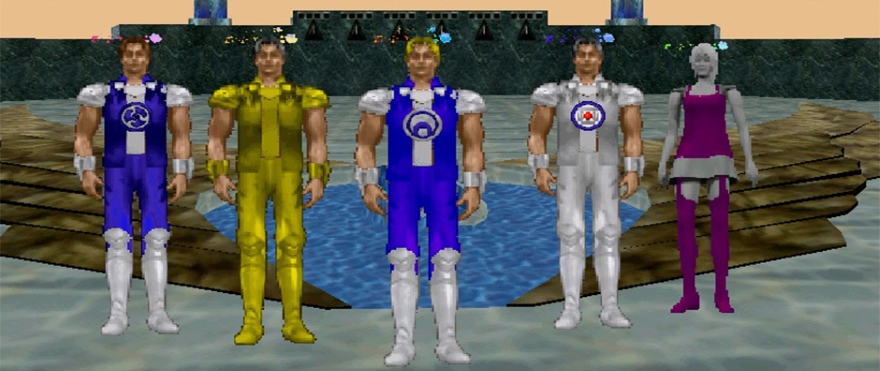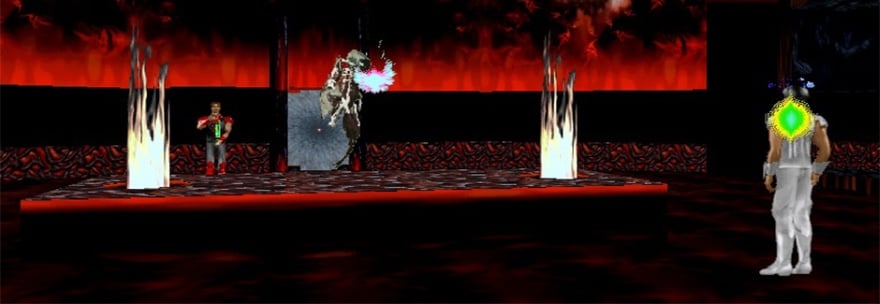
After years of digging into the field of classic MMOs, I know there aren’t too many undiscovered titles that haven’t been brought to my attention (even if I haven’t covered them all yet). But it was a plea on Reddit for a gamer asking for help to remember an older MMO that took place in a “shared dream world” that dredged up a single word: Underlight.
My ears perked up. My eyebrows raised. This… sounded interesting. To the Googlemobile!
I began my usual digging around, piecing together scraps of information that survived from those dark ages of the internet. What these scraps revealed was an MMO that clung to one overriding principle, to roleplay above all else. Even better, it somehow still survives even to this day. So what is Underlight? For that, we’re going to have to go back two decades.
 The “true” roleplaying experience
The “true” roleplaying experience
Back in 1995, tech entrepreneurs Brent Phillips and Brian Jamison decided to co-found a game company, Lyra Studios, with the express purpose of designing an online RPG. While not completely unheard of, online gaming was still a fledgling industry that wasn’t understood in the wider market.
“When we started working on the game in September of 1995, the execs at the large game publishers we visited actually ridiculed our idea that a large-scale graphical RPG was possible,” Jamison said. Even with the daunting task of both building and explaining this game, the team forged ahead in creating Underlight.
Even though it was only one of a handful of prospective MMOs at the time, Underlight separated itself from the combat-centric pack by focusing on an engaging roleplay experience as its core gameplay. The developers saw the potential for true roleplaying with the assistance of hundreds of players that computer RPGs of the past couldn’t achieve.
“In Underlight, everyone who plays contributes to the story,” the studio said during the development process. “Instead of responding to quests that have been prewritten or randomly generated, the players are the story.”
The team further distanced itself from contemporaries by eschewing the traditional stock Tolkien fantasy. Jamison set forth the vision for Underlight: “I’m so sick of Elves, Orcs, and avatars in chainmail bikinis. I figured that we’re creative creatures and we should be able to come up with something different.”
Underlight went into beta in March of 1998 and was released later that year as part of the Mplayer gaming service. “We weren’t the first out of the gate, but we were close,” Jamison wrote. “Meridian 59 beat us to market, and Ultima Online came out ahead of us, but release we did.”
At just 25 MB, the MMO was shockingly small compared to today’s 30-plus GB downloads. Underlight merely required a 14.4k modem, 16 MB of RAM, and an SVGA video card that could handle the whopping 640×480 resolution. Like most online games of the period, it charged a subscription rate (this one at $14.95 a month).
Underlight was most certainly an underdog, being vastly overshadowed by EverQuest and its ilk. Still, the title chugged on into the 2000s, surviving the buyout of Mplayer by GameSpy in 2001 and hiring on the Themis Group to help promote the game in 2002. Efforts were made to grow the brand, including hiring Composer Richard Bone to create a rich soundtrack and providing an ongoing storyline that divided the playerbase.
Even with these decisions, Underlight faltered and floundered as better-looking and higher-budget titles started coming into the market. The roleplaying adventure was living on borrowed time.
 Playing in a dream world
Playing in a dream world
Instead of cobbling together a stereotypical fantasy world, Underlight opted for something more unusual. The premise is that players somehow accessed the titular city of dreams and are forging new lives while asleep. This blank slate offered a common starting ground for all of the participants, and the dev team stated only three rules that everyone had to follow: no cheating, respect others, and stay in-character at all times.
As you can tell by the screenshots in this article, Underlight is a brutally ugly, graphically crude game that harkens back to the Doom era of development. This is a game that the original EverQuest looked at when it wanted to feel like a glamorous princess. Even so, players took up the call and tools to roleplay and engaged in it with gusto.
“I remember the night when Josh Partlow and I stepped out into the live alpha and roleplayed our hearts out wondering, ‘Will they roleplay back?’ And roleplay they did,” Jamison recalled. It also helped that there were no NPCs in Underlight: “When you know that everyone in the game is also a real person, it forces you to roleplay.”
While combat and the acquisition of gear existed, it was greatly deemphasized in favor of players taking up the burden of both providing and engaging in other means of content. By going on tasks for each other and establishing social relationships, players could progress in the magical arts and climb the political ladder.
The game world was rather small compared to most MMOs, consisting of several rooms connected via portals. The city of Underlight had eight major houses that players could curry favor with, although one of these houses fell under the influence of an evil general at one point. There were also nightmare mobs — called Mares — that presented some level of threat. In a cool twist, players could pay a fee to temporarily inhabit the body of a higher-level Mare as part of the roleplaying environment.
Through player interactions and a teacher-student dynamic, Underlight offered an alternative means of progression. Combat between players, while an ever-present reality, was relatively rare and required an RP reason to begin. This was doubly important in 2002, when the team added permadeath (Dreamstrike) into the game.
“I’ve always found the threat of permanent death to be one of the more exhilarating aspects of paper and pencil RPGs, so it makes perfect sense that Underlight would feature permanent character death,” said Phillips.
 Death and rebirth
Death and rebirth
Underlight was facing extinction by the mid-2000s. A small MMO that had never become more than a “footnote,” as Raph Koster put it, Underlight lacked the buffer of a large playerbase for when it started to age. By 2006, Lyra Studios announced that it was closing shop, and so was Underlight.
This was a doubly harsh blow considering that Lyra was then hard at work on a sequel for the game called Underlight: Reclamation. Reclamation had been in development since 2004, had started alpha testing in early 2006, and was billed as “the next-generation evolution from its predecessor.” But when Lyra went, so did the hopes that a sequel would finally put this franchise on the map.
While no longer attached to Underlight in 2006, Brian Jamison said that he felt the impact of the news even so. Still, Jamison said that he didn’t regret the project: “The game lived a far longer and richer life than I ever imagined, though it never became the success that we all believed it should.”
Fortunately, the game was not cast into the abyss but passed along to other handlers, including Underlight’s own community. Ixios Development repackaged the MMO as Underlight: Shades of Truth and kept it running through 2013. Red Coat Games took over the game for a portion of that year, calling it Underlight: Echoes of Chaos, before selling the license to KoiWare in 2014. [KoiWare has corrected our original post to clarify the provenance of the game. “We purchased it directly from Brent and Lyra Studios – the contract strictly stipulates that the license to operate could not be sold from one Gaming Company to another and that it needs purchased directly from Lyra/Brent,” the studio told us in 2017. “Granted we worked with Red Coat to get their player database to merge alongside the original Lyra Database but their was no license hand-off between our two entities.”]
This turned out to be a good move that would reunite the community. KoiWare’s Underlight: Clash of Dreams connected the current game with past accounts, allowing players to import characters from previous versions when it went live in September 2014. The company made the game available for free (it survives on donations) while its dev team added more content.
For a very niche, nearly two-decade-old MMO, I have to admit that this is the best it could have hoped for in this day and age. If you can excuse the graphics and lose the combat-centric mentality, then it might behoove you to don a roleplaying attitude and see what Underlight has to offer.
 Believe it or not, MMOs did exist prior to World of Warcraft! Every two weeks, The Game Archaeologist looks back at classic online games and their history to learn a thing or two about where the industry came from… and where it might be heading.
Believe it or not, MMOs did exist prior to World of Warcraft! Every two weeks, The Game Archaeologist looks back at classic online games and their history to learn a thing or two about where the industry came from… and where it might be heading.














